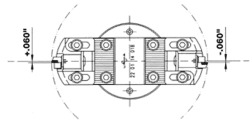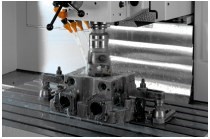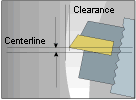Big Boring On Smaller Machines
This modular boring system lets you bore holes up to eight inches in diameter on machining centers with 40-taper spindles.
Share




Hwacheon Machinery America, Inc.
Featured Content
View More




Those smaller, affordably priced vertical machining centers from Fadal, Haas, and a score of other domestic and off-shore builders, are a great value. That's why so many shops are buying them. It's hard to beat their combination of low cost, high flexibility, and money-making productivity.
Users everywhere are trying to move as much work across those machines as possible. That's understandable. These machines are economical and effective, so striving to get the most out of them makes good sense. In particular, there is a trend to machine larger and larger workpieces on these widely used machines.
But there's a hitch. Many of the most popular models in this class of machines have 40-taper spindles, with spindle motors typically in the 10- to 15-hp range. For the size of the average work envelope on these models and the kinds of machining operations these machines are usually devoted to, this size and power of spindle is a good match. However, some operations just aren't going to work very well, given the limitations of the torque and thrust these machines can deliver.
A good case in point is the boring of larger holes—over 5 inches in diameter, for example. These are features typical of larger workpieces. Cast iron pump bodies are some of the commonly encountered workpieces that often call for hole boring in these larger sizes. Other examples might include valve components, mold bases, die plates, and some aluminum aerospace components.
The problem is that conventional boring tools for boring holes this large are generally designed for larger machines. These tools most often have 45- or 50-taper toolholder shanks and are built for the forces larger machines can deliver. Components are relatively big and heavy as a result. The total weight usually exceeds what the automatic toolchanger on a 10-hp machine can handle. In other words, tools for boring holes this big are also too big for the 40-taper, 10-hp machines that are so popular.
Of course, with so many of these smaller machines out in shops and plants, it is no surprise that the tooling companies are beginning to respond to the need for tooling that overcomes the inherent limitations of these machines. The goal is to use the thrust and torque that these machines can deliver in new and more efficient ways. We are already seeing the arrival of boring tools that allow large diameter boring on 40-taper machines, for example. They are a good example of how cutting tool manufacturers are dealing with the realities of today's machine population.
Lighter, Smaller
The IntraMax large-diameter boring system demonstrates how tooling can be redesigned for effective operation on lower horsepower machines. This system was developed in Europe by URMA, a tooling company based in Switzerland, and recently introduced into the North American market by Command Tooling Systems (Ramsey, Minnesota). The system is built around adapters for 40-taper tool-holders as well as HSK-style toolholders.
This boring system is designed to be light in weight but rigid and accurate. Significantly, it is also designed for flexibility, in keeping with the mentality of the small-machine user intent on getting the most out of every machining resource. For example, the system is modular. By interchanging the diameter extenders, the same roughing and boring heads can be used to bore diameters from 3.5 to 8.1 inches. Figure 1 (at right) shows a cutter assembled for the maximum diameter.
A similar combination of components can be used for machining ODs on bosses from 0.35 to 3.9 inches in diameter. (For this OD "turning," the boring heads are simply clamped with the inserts facing inward, as shown in Figure 2, below right.) In all cases, the system uses standard diamond-shaped inserts, both for roughing and finishing.
To reduce weight, these boring tools use high-strength materials but are "downsized" appropriately. Smaller dimensions are allowable because cutting forces are limited by the horsepower of the machine. There's no point in building a tool for heavy cuts when the machines it will run on can't make heavy cuts to begin with.
Nevertheless, to make boring an efficient operation, as much of the machine's available torque as possible must be utilized. To this end, the interfaces between components feature ground serrations that increase the area of contact between mating surfaces. The added rigidity of this design allows all of the machine's torque to be applied without chatter.
Of course, machining parameters have to reflect the limitations imposed by spindle horsepower. It's not possible to do a 20-hp machining operation with a 10-hp spindle. But it is possible to maximize metal removal with the available spindle power. Typically, large bores can require up to 0.5 inch material removal from the part. In these cases, the IntraMax system has the metal removal capabilities, but a 10-hp spindle may not. Thus it may require an extra operation to remove all of the required material. This would depend on the type of material and the strength of the spindle. But if the workpiece is being considered for a smaller machine, it probably doesn't have a lot of material to be removed and thus may require only a light roughing and finishing pass. And in some cases, the only operation required may be a finishing pass of merely 0.01 to 0.05 inch per side.
Efficiency
Okay, so this kind of boring tool is not going to make the kinds of cuts you make on a larger machine. But that doesn't necessarily mean sacrificing efficiency. The IntraMax system also is designed to allow roughing and finishing in a single pass. In other words, the lead cutter is set up for a roughing pass while the trailing cutter is set up for a finishing cut. In one pass, a bore can be roughed (up to 0.1 inch depth of cut) and finished (0.010 to 0.015 inch depth of cut) with the same tool.
Obviously, eliminating the additional finishing pass reduces total cutting time—by as much as 50 percent on bores requiring one roughing and one finishing pass. This strategy also means one less tool in the toolchanger, not to mention the advantage of having one tool do the work of two in terms of tooling costs.
Double cutter finishing is another possibility. Because both inserts are devoted to finishing, feed rates can be doubled compared to a single-cutter operation. The key to double cutter finishing is getting the tool out of the bore without dragging the inserts along the sidewalls of the hole, thus marring the surface finish of the bore.
The IntraMax system handles this by allowing the cutting edges to be set slightly off the center line of the extender bar, as shown in Figure 3 (at right). The leading insert edge will be offset 0.060 inch below the center line and the trailing insert edge on the opposite side will be offset 0.060 inch above the center line. When the tool reaches the bottom of the bore, the spindle has only to rotate 0.060 inch in the opposite direction to return the edges of the insert to the center line.
This moves the cutter off the wall of the bore, providing sufficient clearance to retract the tool without scratching the walls. And the tool can be retracted at a rapid traverse rate to save time. Most canned boring cycles include a line for jogging the spindle at the end of the bore, so using this technique does not complicate programming.
Accuracy
Low cost vertical machining centers have put CNC machining within the grasp of many first-time users. One of the areas that often has newcomers guessing is how accurate CNC machining can be. Another is just how much that accuracy will cost.
According to Gregg Van Waes, product manager for the URMA line of boring systems, newcomers are usually surprised that precision boring of large-diameter holes is feasible on entry-level CNC machines. They are also surprised by how economical it can be.
The IntraMax system, for example, allows boring diameters to be adjusted in 0.0002-inch increments for precise finish cuts. These are accuracies usually associated with high precision boring tools for small holes (under 1 inch in diameter). Larger diameter bores typically have slightly more open tolerances than small holes. Similarly, boring tools tend not to offer as accurate adjustability of the larger sizes compared to the smaller sized tools. Because boring tools are expensive enough, manufacturers feel that if the accuracies are not typically needed, why include the added expense?
Despite its high level of accuracy, this tooling system is priced favorably in comparison to conventional boring systems for 45- or 50-taper spindles, which are customarily used for holes of this size.
Toolchanger Considerations
Smaller vertical machining centers most typically have automatic toolchangers with 12 to 20 tool pockets. Typically, the weight limitation on these tools is 15 pounds. Conventional boring systems that match the range of the IntraMax can weigh up to twice that. However, by virtue of smaller components, the IntraMax system stays below the toolchanger weight limits on smaller machines.
However, that doesn't mean the user is entirely home free. Regardless of weight, any boring tool 5 to 6 inches in diameter can have clearance problems going from the spindle to the tool carousel. Because a small spindle would have trouble pushing a face mill of that diameter, for example, there's no point in supplying clearance for such a large tool. The IntraMax system can avoid this clearance problem because there are only two cutting edges to the tool. The system can be assembled with the widest part of the tool in any location within 360 degrees of the drive slots. This allows the widest part of the tool to be turned in such a way that it clears the machine sheet metal on its way to the carousel.
In some cases, it may be necessary to leave adjacent toolholders empty. However, these are pockets likely to have been occupied by tools made redundant by the flexibility of the system, such as the extra roughing or finishing tool that is no longer needed.
A Niche
Of course, large diameter boring is a niche not every shop will need to fill. Nevertheless, applications are becoming more common, as larger workpieces migrate to smaller machine tools. The development of boring systems that address this trend is just one indication that tooling companies are responding to the interests of shops operating these extremely popular low cost machining centers.
No doubt, other developments in tooling will extend the capability and applicability of these machines—making them even more valuable as the new workhorse of today's machine shop.
Related Content
Kennametal's Expanded Tooling Portfolio Improves Performance
The company has launch eight new products that expand on and support existing platforms across multiple applications.
Read MoreFinding the Right Tools for a Turning Shop
Xcelicut is a startup shop that has grown thanks to the right machines, cutting tools, grants and other resources.
Read MoreCustom PCD Tools Extend Shop’s Tool Life Upward of Ten Times
Adopting PCD tooling has extended FT Precision’s tool life from days to months — and the test drill is still going strong.
Read MoreThe Future of High Feed Milling in Modern Manufacturing
Achieve higher metal removal rates and enhanced predictability with ISCAR’s advanced high-feed milling tools — optimized for today’s competitive global market.
Read MoreRead Next
5 Rules of Thumb for Buying CNC Machine Tools
Use these tips to carefully plan your machine tool purchases and to avoid regretting your decision later.
Read MoreBuilding Out a Foundation for Student Machinists
Autodesk and Haas have teamed up to produce an introductory course for students that covers the basics of CAD, CAM and CNC while providing them with a portfolio part.
Read MoreRegistration Now Open for the Precision Machining Technology Show (PMTS) 2025
The precision machining industry’s premier event returns to Cleveland, OH, April 1-3.
Read More









































.png;maxWidth=300;quality=90)






.jpg;maxWidth=300;quality=90)








